Here at the Alliance of Independent Authors (ALLi) we think of our author community as a family – but what happens if you take on the challenge of writing with an actual family member? Find out more about the benefits and challenges of writing and publishing a book with a family member in this Ultimate Guide.

Photo by Alexis Brown on Unsplash
Keeping it in the family
Writing is often a solitary pursuit; stolen hours in the dead of night, tapping away on the commute with your headphones on, or just the cat keeping your feet warm as you sit alone in the writing shed.
So the idea of embarking on a literary adventure with a collaborator – a family member at that – may fill you with excitement… or more likely trepidation. But what if it was a way to bring a new dynamic to your writing and strengthen your relationship?
In this week’s post, we'll explore the benefits, challenges, and considerations of writing in collaboration with a family member. We’ll also hear from two writers who have done just that: Holly Greenland, ALLi's newest team member, who wrote a novel with her son; and Janet Bastyan, an ALLi member who wrote a memoir in partnership with her husband.
Let's kick off with the positives, as we outline five of the top benefits of writing and publishing with a family member.

Photo by Thought Catalog on Unsplash
Publishing with a family member: top five benefits
Unique skill sets
Every family member can bring their own set of skills and expertise to the table. Someone might excel at crafting dialogue, while another could be skilled at world-building or plot development. Combining these strengths can result in a more well-rounded and engaging novel than one produced in isolation. Plus, learning from each other's skills can be a valuable educational experience.
And don’t forget that beyond writing, the end-to-end publishing process will require further skills and experience; from design and formatting, to marketing, or negotiating with and managing suppliers. Each step on the self-publishing processes can be an opportunity to utilise the different skills and experience both of you bring.
Double the inspiration
Writing a novel alongside a family member can double your pot of inspiration to draw from. Shared experiences and family anecdotes can trigger ideas that might have remained dormant otherwise. Alongside this, the diverse perspectives and life experiences brought by collaborators of different ages, genders, identities and personalities can bring a new depth and authenticity to your characters, settings, and themes.
If your family collaborator has a different favoured genre, this too can bring fresh creative touch-points to your work; how about your favourite horror tropes played out within your sibling’s family saga plot? Or your dad’s cosy mystery investigation taking place within your own romantic comedy setting? Combining established ideas in new ways can spark concepts that may have otherwise remained closed off.
Shared support systems
Collaborating with a family member offers a built-in support system. Having someone to share the highs and lows of the creative process with can relieve those exhausting feelings of isolation that often come hand-in-hand with solitary writing, and take some weight off your shoulders. Mutual encouragement, creative sessions and celebrating milestones together can boost motivation and keep the momentum going.
A longer-term benefit of undertaking a shared creative project, is the deepening of the bond between family members. Working collaboratively is the perfect way to create memories for the future, and a mutual understanding of one another that extends beyond the final pages of the book.
Awakening the inner child
If you are writing with a sibling or parent, the creative process can become a nostalgic journey that transports you back to your own childhood. As you progress together, you may find long forgotten memories resurfacing; recollections of bedtime stories you loved, the dreams you nurtured, and the adventures you embarked upon.
When writing with a child, the creative process can also bring a new dynamic to your writing. As you hear the story develop through their youthful language, perspective, and feelings, you may find you awaken your own inner child. Words, thoughts and a creative freedom that you haven't accessed since you were young may come to the surface.
Honesty and openness
The close bond that comes with a familial relationship can bring a unique honesty to conversations and creativity that just isn’t there if collaborating with a friend, colleague or expert.
That close connection can inspire open and honest creative development that will uncover new concepts, plot twists, and characters that may have been inhibited if working alone or with a more distant contact.

Photo by Jason Dent on Unsplash
Navigating the potential pitfalls of publishing with a family member
While writing a novel with a family member undoubtedly offers many creative and personal benefits, it's also important to acknowledge the potential for challenges along the way.
Just like with a family game of monopoly at Christmas, what begins as a fun activity can quickly breakdown if a disagreement arises. These can range from misunderstandings over roles, difference in perception of equal input, or at its most challenging (and possibly costly), financial and legal disputes after your book has launched.
Authors can mitigate potential issues through early conversations, planning and agreements. So, before you consider setting off on a family-writing project, undertake these five actions:
Set clear roles and responsibilities
Establishing clear roles and responsibilities from day one will help to ensure a harmonious collaboration on what might be a long and complex journey. An agreed division of work should reflect each person's strengths (and weaknesses). Is one person stronger at developing characters, and another adding detailed descriptions of time and setting? You may find that while one person has more focus on the early creative development, the other is stronger at editing and refinement later down the line.
When writing a first novel together, this division of labour may take some trial and error. It can help to agree check-in points along the way, when you can pause to have an open discussion about what’s working and what may need to change. This will ensure resentment doesn’t build on one or both sides. Calm and honest communication here is key.
Agree financial and legal arrangements
Before putting pen to paper, have a more formal meeting to agree on the key financial and legal elements of the project, making sure any agreements made are put down in writing and signed by both parties.
Some areas to discuss and agree include:
- Funding: understanding how you will fund your project before you start will help avoid any nasty surprises. For example, are you considering cover-art, a launch event, advertising, or legal representation? If so, how will you divide costs between the two of you, and does this impact earnings later down the line? Remember, you can also work in ways that limit these costs, or remove them completely, depending on your goal for your book. If you go down the no-cost route, agreeing this up front is also important for managing expectations on both sides.
- Earnings: agreeing a fair division of any potential earnings may consider factors such as each individual’s time investment, skills, or role contributions. Alternatively, you may agree that regardless of practical input, division of earnings will be 50/50 to reflect the joint endeavour. Either way, agreeing on the percentage split of any money made and how payments will be managed up front offers clarity to both sides.
- Copyright and ownership: define who holds the rights to the work and how you would like (and not like) it to be distributed or used in the future. ALLi can help you with all you need to guide your conversations and decisions about this. If you don't understand key terms, the Contracts for Indie Authors Glossary is a great place to start. Members of ALLi can also request legal advice from our legal team or dedicated literary agent. Just log into the member zone and navigate to Advice–> Contracts, where you'll find advice, details of our contract review service, and sample annotated contracts.
Manage creative differences
You and your family member might have differing visions for the story, either at the outset, or that emerge as the work progresses. Learning to compromise is crucial to maintaining a productive partnership. Remember that time away from your ideas can also help get perspective. If creative discussions are becoming heated, have a shared signal to show that one or both of you need some time out.
If working with children, bring extra patience with you. Depending on their age, your child might not fully grasp the intricacies of plot development or character arcs and you may find their ideas head off in unexpected or challenging directions. Patience is key as you guide them through the storytelling process, offering gentle explanations and encouragement for why your story may need to tread a different path. You’ll often find they are more open than you may think to compromise.
Agree time commitments
There are different ways to approach your time together. Will you be writing sections to send back and forth, or sitting down at particular times each week to write collaboratively? Will it be in person, or via a video call?
Whatever approach you take, coordinating schedules can be challenging, especially if you have different commitments and responsibilities. Agree a way of working that suits both of you, even if that means working independently for some of the time, and then coming together at agreed moments. There are lots of ways to make it work.
Remember, if writing with a child, they will most likely have a shorter attention span and become easily distracted. Keep writing sessions engaging and concise to maintain their interest. Expect that you may work together intensely for twenty or thirty minutes, then they will need time to do something completely different or take a break while you refine the work further. Gathering their creative ideas, rather than working on the detail, may be the priority for your time with them.
Know when the working day ends
If you live with your writing partner, establishing boundaries between writing and normal life can be important. Just like with a family business, a division between ‘talking shop’ and personal space makes sure one relationship does not take over the other.
This may happen naturally when you close the computer or your notepad, but if you find the book is taking over other family life, agree some ground rules. You could choose a cut-off time in the evening where conversations should not touch on the book, or agree that only when you're in your ‘writing space’ can the book be discussed.
A challenging but rewarding journey of collaboration
Overall, if planned carefully together, writing with a family member can be a rewarding and transformative experience; a journey that involves shared creativity, mutual support, and the potential to bring together differing ideas and experiences to create something new. The process can help create not only a captivating book, but also lasting memories that will strengthen your relationship further.
So, if writing in a collaboration interests you, keep your eyes open at your next family get together, your new writing partner may have been right under your nose the whole time.
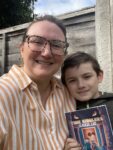
Family writing partnership, Holly and Gus, with their finished book.
Case Study One: Holly Greenland & Gus Yardley
Holly Greenland is an author, content writer, and PhD researcher investigating the impact of self-publishing on the industry. She is also Content Editor here at ALLi. You can find out more about Holly on her website.
Do you remember the global lockdown? Of course you do. It was a nightmarish combination of terrifyingly awful and mind-numbingly boring days looming ahead of us. And if you were a parent during that time, I’m certain you will also have vivid memories of the shock, awe and pain brought about by the horrors of unexpected home-schooling.
As the lockdown continued much longer than any of us had imagined, like many across the world, I became determined to find some light in the darkness. Scaredy cat was that light for me and my oldest child, Gus.
Establishing a writing partnership with a 10-year-old
My son had always been a big reader, and this became even more important during lockdown as a route to escapism during that unsettling time. One long lockdown evening, we discussed why the books he loved so much were almost always set in the US. This wasn’t a problem for him, but a surprise. He wanted to read a story based where he lived, with kids like him involved in a mystery, and a few jump scares and spooky twists along the way (Goosebumps are a big favourite). I’m sure we could have searched around to find the right fit, but when Gus suggested we write our own story, I jumped on it.
So, amid face masks, “happy birthday” hand-washing and social distancing, Gus and I embarked on a collaborative writing journey that resulted in a short story of around 6,000 words – the tale of a young boy (not unlike Gus) who disappears back in time when he touches an Egyptian statue and discovers the mystery of a missing archaeologist.
Building a collaborative process and routine
We established our writing process through trial and error, but the way we worked was surprisingly smooth from the outset. Gus would come up with an idea, and I would make careful suggestions to expand the concept, draw out more detail, or connect elements together. The one clear rule was that we would only move on to the next section once Gus was happy.
I found our ideas and skills generally complemented one anothers. Gus's vivid imagination breathed child-like life into characters and settings that I may not have found alone, while I provided guidance on structure, pacing, and plot development that ensured a fully formed story came out the other end.
We established a routine where we'd sit down each day for around half an hour to write and discuss the story, and I would spend a little longer once his patience ran out editing what we had produced that day.
Though his patience may have been short in each writing session, it never lessened for the project itself. His enthusiasm was infectious, driving us forward even when the challenges of lockdown threatened to stall other projects at home.
Our routine and Gus's motivation not only led us to complete the story in a matter of weeks, but provided a sense of normalcy and purpose for us, offering an escape from the anxiety surrounding the pandemic.

Photo by Glenn Carstens-Peters on Unsplash
Lessons learnt: writing and publishing with a family member
Collaborative writing with a ten-year-old comes with a hard and fast lesson in writing from the heart and without hesitation.
I learnt a lot from Gus’s completely unfiltered idea generation. Because Gus rarely had fears that his ideas were “not good enough”, we never hit a block. I simply typed down all the thoughts as they came to him, however off-the-wall or mundane, knowing we could tweak after. This was an important reminder for me that writing something imperfect is better than writing nothing at all.
On the other hand, Gus had to learn to listen to reason when occasionally his enthusiastic plot twists led to issues maintaining a cohesive storyline, or created contradictions from one chapter to the next. His natural inclination is to stand his ground against others who question his ideas, which I wouldn’t want to dampen. But the process we went through showed Gus that despite our best efforts, none of us can be right all the time. Sometimes listening to experience, or developing your original idea with input from others, can lead to an even better idea. Compromise at the right time isn’t about losing. I hope this is a lesson that will help him in the future too.
And I will always remember the shared squeals of excitement when we found our flow; layering our ideas one on top of the other to build the perfect cliff hanger, or the ideal surprise twist to torment our main character.
Legacy beyond lockdown
When we first completed Scaredy Cat as a short story, we were only looking to share it with family and friends. So, at that stage we chose a copy-right free image for the cover and put it onto Amazon as an ebook simply to create a link to share easily. I set the price as low as possible, and Gus was delighted to see some sales come in and hear people’s feedback. We kept it live for a few months only, and it was perfect for what we needed.
Then, not long after we completed our book, lockdown eased and real life recommenced. It wasn’t until earlier this year that the book came back up in conversation, and Gus and I decided there could be more to our story than we first thought.
With Gus now ten and me working and studying more, we approached our writing partnership in a more structured way. Gus and I read the book again and agreed on some expansion areas. With my background in writing education resources and Gus’s newfound love of riddles, I also suggested that we add in a puzzle at the end of each chapter for the reader to complete. Gus signed it off!
With school resumed, I used a little time in the day to take each chapter and rework it with the changes we’d discussed, then we would sit in my office each evening and I would read Gus the chapter out loud. He would ask questions, add ideas and veto some words or actions and we would sign off the book chapter by chapter.
In the end we had a 20,000-word chapter book, and I put it live again in the summer, this time choosing to create a print version too. This meant Gus could take some copies in to the school library and share with his friends.
I have to credit the brilliant Onyine Iwu here — I worked with Onyinye on a project in a previous role and she was the perfect choice to produce the cover art and some internal images for Scaredy Cat. We were lucky she could fit us in her busy illustration schedule and Gus was fully involved in the briefing, amends, and sign off for designs. Another great shared experience for us.
Live and in colour
This has really been a passion project for Gus and me. Of course, it’s been satisfying to see sales for the book coming through, but the best outcome from the process has been seeing the confidence boost it has given Gus. Watching him sign his author copies for the school library and the PTA summer raffle, and hearing the response from his class when he read chapter one for “show and tell”, was priceless.
This book is out there now, and there will always be copies around with mine and Gus’s name on the front together. That’s a real legacy we can both feel proud of achieving together.
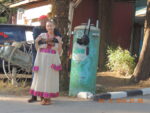
Mesfin and Janet in Addis Ababa
Case Study Two: Janet Bastyan and Mesfin Tadesse
Janet Bastyan wrote Lucy’s People: An Ethiopian Memoir with her husband Mesfin Tadesse. You can find out more about Janet on her LinkedIn profile.
Tell us about your book and how your writing partnership came about?
I wrote Lucy’s People: An Ethiopian Memoir in partnership with my husband to tell the story of an Ethiopian-born Australian resident. I am Australian. It’s his story.
The memoir spans May–June 1991: the Derg downfall and TPLF-rebel advance. It follows Mesfin as a 30-year-old engineer who has survived the Red Terror but is now out of work as projects fold. Mesfin and his pregnant wife must consider whether to flee persecution and the renewed conscription to foreign-backed warfare.
Mesfin and I produced two editions: April 2020 in Addis Ababa and then August 2021 in Perth, Western Australia. During the pandemic’s peak, Australia capped arrivals, stranding us for 13 months, which gave us unexpected time to work on the project.
Q: How did the collaboration work?
Mesfin gave me oral recounts in English. Without recording him, I scrawled notes to process my emotions and retain concepts. Keeping journals was my lifelong habit, so writing about our conversations every few days came naturally. Some conversations were hours long; others lasted minutes. I kept quiet and listened actively.
Two years on, we agreed that Africans and others deserved to hear his story. My hands automatically typed the draft, including a sequel still to come. I took responsibility for structuring the narrative, reading bits aloud to Mesfin for feedback.
It was a difficult time to be publishing. In 2020, we had to protect our printer’s identity. By 2023, the Ethiopian government persecution of creators was rampant. We designed the cover ourselves, juxtaposing our nature photos with images of military artefacts.

Mesfin at Lake Tana in 2020
Q: How did you manage the financial and copyright side of the project?
I bought ISBNs and services, keeping partnership documents for Mesfin. When I signed up with KDP and IngramSpark, we went together to a bank and opened an account to receive royalties and lending rights from the copyright agency. Profits are split 50/50 after any big production costs, although I funded editing and design as a marriage gift.
I insisted that only his name be on the cover to keep it streamlined. But both our names are on the title page, which is the primary bibliographic source for libraries.
Q: What was most successful about writing and publishing with a family member?
Our relationship brought trust that helped us share a challenging story. Holding the first edition inspired further trust in Mesfin, who furnished two fresh chapters’ worth of material for the second edition.
This gave us the opportunity for further updates. Ethiopia’s calendar being different, I corrected dates and added a multilingual bibliography— valued by Africans—with notes and reflections, and I outsourced a more ‘professional’ cover design. This new cover was prettier, but reader feedback was that many preferred our original rough ‘n’ ready version.
Q: What would you change if you were to do this again?
I am now planning for the sequel and from my first experience I will:
- Publish simply, but professionally – jaded readers for my topic want memoirs that are real with less slick production
- For stronger authorial voice, I’m planning to speak the first re-draft using voice-recognition software
- For the cover, I will think again about whether the slick or more ‘rough and ready’ style suits my topic.
For more in-depth advice on all aspects of self-publishing, visit ALLi’s Bookstore

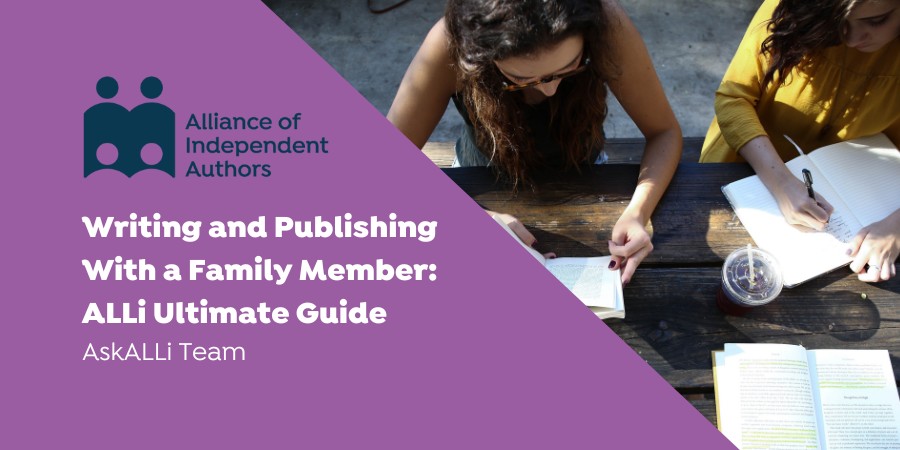
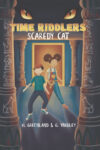
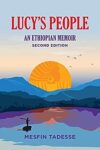



Great article! My wife and I write science fiction together (under the pen name Trigger Jones). As you state, there are both benefits and challenges. We bring different skill sets to the job, and different perspectives. As an example, Juanita often breathes a life into our female characters that I would never reach.
In addition to bringing our mutual love of stories deeper into our life, co-writing has also deepened our communication skills with each other. It can be a fiery process – but I highly recommend it.